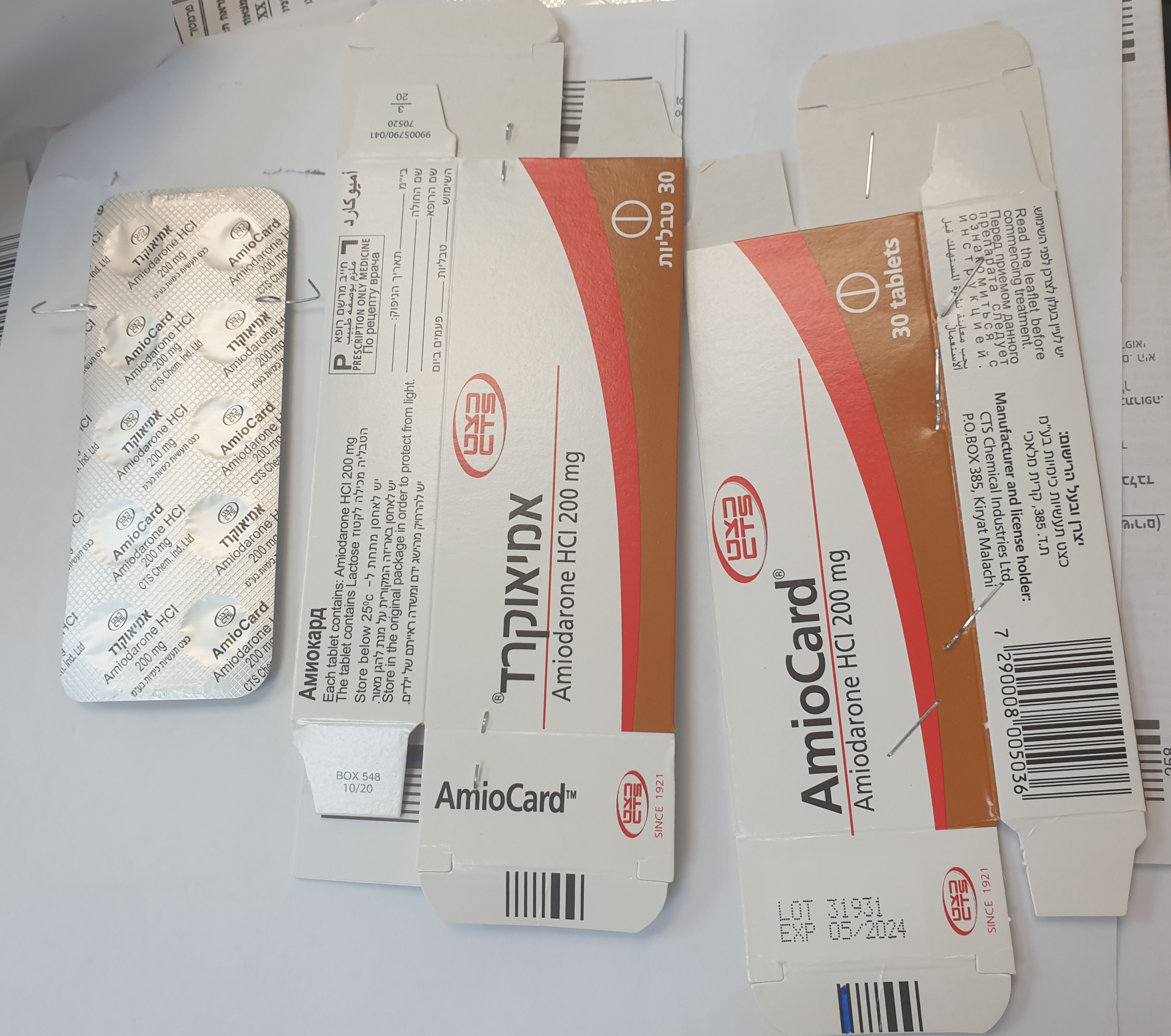Quest for the right Drug

אמיאוקרד AMIOCARD (AMIODARONE HYDROCHLORIDE)
תרופה במרשם
תרופה בסל
נרקוטיקה
ציטוטוקסיקה
צורת מתן:
פומי : PER OS
צורת מינון:
טבליה : TABLETS
עלון לרופא
מינוניםPosology התוויות
Indications תופעות לוואי
Adverse reactions התוויות נגד
Contraindications אינטראקציות
Interactions מינון יתר
Overdose הריון/הנקה
Pregnancy & Lactation אוכלוסיות מיוחדות
Special populations תכונות פרמקולוגיות
Pharmacological properties מידע רוקחי
Pharmaceutical particulars אזהרת שימוש
Special Warning עלון לרופא
Physicians Leaflet
Adverse reactions : תופעות לוואי
4.8 Undesirable effects The following adverse reactions are classified by system organ class and ranked under heading of frequency using the following convention: very common (≥ 10%), common (≥ 1% and < 10%); uncommon (≥ 0.1% and < 1%); rare (≥ 0.01% and < 0.1%), very rare (< 0.01%), not known (cannot be estimated from the available data). Blood and lymphatic system disorders: Very rare: • haemolytic anaemia • aplastic anaemia • thrombocytopenia In patients taking amiodarone there have been incidental findings of bone marrowgranulomas. The clinical significance of this is unknown Not Known: • neutropenia • agranulocytosis Cardiac disorders: Common: • bradycardia, generally moderate and dose-related. Uncommon: • onset or worsening of arrhythmia, sometimes followed by cardiac arrest (see sections 4.4and 4.5.) • conduction disturbances (sinoatrial block, AV block of various degrees) (see section 4.4) Very rare: • marked bradycardia or sinus arrest in patients with sinus node dysfunction and/or inelderly patients. Not known: • Torsade de pointes (see section 4.4 and 4.5) Injury, poisoning and procedural complications Not known: • Primary graft dysfunction post cardiac transplant (see section 4.4) Endocrine disorders (see section 4.4): Common: • hypothyroidism • hyperthyroidism, sometimes fatal Very rare: • syndrome of inappropriate antidiuretic hormone secretion (SIADH) Eye disorders: Very common: • corneal microdeposits usually limited to the area under the pupil, which are usually only discernable by slit-lamp examinations. They may be associated with colored halosin dazzling light or blurred vision. Corneal micro-deposits consist of complex lipid deposits and are reversible following discontinuation of treatment. The deposits are considered essentially benign and do not require discontinuation of amiodarone. Very rare: • optic neuropathy/neuritis that may progress to blindness (see section 4.4). Gastrointestinal disorders: Very common: • benign gastrointestinal disorders (nausea, vomiting, dysgeusia) usually occurring withloading dosage and resolving with dose reduction. Common: • constipation Uncommon: • dry mouth Not known: • pancreatitis/acute pancreatitis General Disorders: Not known: • Granuloma, including bone marrow granuloma Hepato-biliary disorders: (see section 4.4): Very common: • isolated increase in serum transaminases, which is usually moderate (1.5 to 3 times normal range), occurring at the beginning of therapy. It may return to normal with dosereduction or even spontaneously. Common: • acute liver disorders with high serum transaminases and/or jaundice, including hepaticfailure, which are sometimes fatal Very rare: • chronic liver disease (pseudo alcoholic hepatitis, cirrhosis), sometimes fatal. Immune system disorders: Not known: • Angioneurotic oedema (Quincke’s Oedema) • Anaphylactic shock/anaphylactoid reaction including shock Investigations: Very rare: • increase in blood creatinine. Metabolism and nutrition disorders: Not known: • decreased appetite Musculoskeletal and connective tissue disorders: Not known: • lupus like syndrome Nervous system disorders: Common: • extrapyramidal tremor, for which regression usually occurs after reduction of dose or withdrawal • nightmares • sleep disorders. Uncommon: • peripheral sensorimotor neuropathy and/or myopathy, usually reversible on withdrawalof the drug (see section 4.4). Very rare: • cerebellar ataxia, for which regression usually occurs after reduction of dose orwithdrawal • benign intracranial hypertension (pseudo-tumor cerebri) • headache • vertigo Not known: • parkinsonism • parosmia Psychiatric disorders: Common: • libido decreased Not known: • confusional state/delirium • hallucination Reproductive system and breast disorders: Very rare: • epididymo-orchitis • impotence. Respiratory, thoracic and mediastinal disorders: Common: • pulmonary toxicity [hypersensitivity pneumonitis, alveolar/interstitial pneumonitis or fibrosis, pleuritis, bronchiolitis obliterans organising pneumonia (BOOP)], sometimes fatal (see section 4.4). Very rare: • bronchospasm in patients with severe respiratory failure and especially in asthmatic patients • surgery (possible interaction with a high oxygen concentration) (see sections 4.4 and4.5). Pulmonary haemorrhage (there have been some reports of pulmonary haemorrhage, although exact frequencies are not known) Skin and subcutaneous tissue disorders: Very common: • photosensitivity (see section 4.4). Common: • slate grey or bluish pigmentations of light-exposed skin, particularly the face, in case of prolonged treatment with high daily dosages; such pigmentations slowly disappear following treatment discontinuation. • Eczema Very rare: • erythema during the course of radiotherapy • skin rashes, usually non- specific • exfoliative dermatitis • alopecia Not known: • urticaria • severe skin reactions sometimes fatal including toxic epidermal • necrolysis/Stevens-Johnson syndrome • bullous dermatitis and drug reaction with eosinophilia and systematic symptoms Vascular disorders: Very rare: • vasculitis. Reporting of suspected adverse reactions Reporting suspected adverse reactions after authorisation of the medicinal product is important. It allows continued monitoring of the benefit/risk balance of the medicinal product Any suspected adverse events should be reported to the Ministry of Health according to the National Regulation by using an online form https://sideeffects.health.gov.il.

שימוש לפי פנקס קופ''ח כללית 1994
Ventricular & supraventricular arrhythmias not responding to other treatments, tachyarrhythmias associated with Wolff-Parkinson-White syndrome
תאריך הכללה מקורי בסל
01/01/1995
הגבלות
תרופה שאושרה לשימוש כללי בקופ'ח
מידע נוסף
עלון מידע לצרכן
01.08.21 - עלון לצרכן אנגלית 01.08.21 - עלון לצרכן עברית 01.08.21 - עלון לצרכן ערבית 11.10.22 - עלון לצרכן אנגלית 11.10.22 - עלון לצרכן עברית 11.10.22 - עלון לצרכן ערבית 12.06.23 - עלון לצרכן אנגלית 12.06.23 - עלון לצרכן עברית 12.06.23 - עלון לצרכן ערבית 13.05.12 - החמרה לעלון 19.10.15 - החמרה לעלון 01.08.21 - החמרה לעלון 11.10.22 - החמרה לעלוןלתרופה במאגר משרד הבריאות
אמיאוקרד